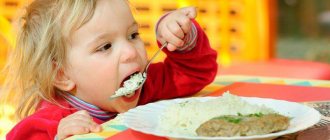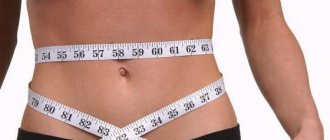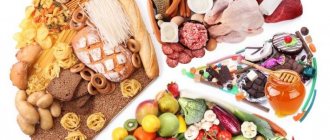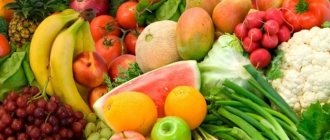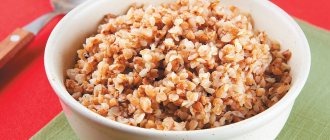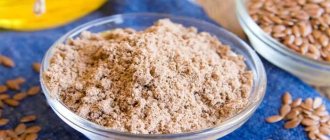Many of us are familiar with the word “diet”. Some have tried more than one of them in the hope of quickly losing kilos. But it often happens that after leaving the diet, all the lost kilograms return to their owner, taking “friends” with them. Why is this happening?
What should your diet be like after a diet so that your weight remains normal and your reflection in the mirror always makes you happy? First of all, it must be healthy! In fact, everything is not very difficult, you just need to set yourself up correctly from the very beginning and give up the dream of “eating everything as soon as the last day of the diet is over.”
To understand what to do after a diet, you need to understand the essence of the issue and understand why we so want all sorts of “harmful things” after losing weight.
Eat regularly
For people who do not engage in sports or heavy physical labor (and if you have problems with excess weight, then you are most likely one of them), it is recommended to eat 4-5 times a day. The intervals between meals should be no more than 5-6 hours. If you eat less often, you tend to eat more, because a strong feeling of hunger makes it harder to stop on time and more difficult to control the amount of food you eat. Remember a simple rule: the less often you eat, the more likely you are to gain extra pounds.
Diet for high acidity
For stomach pain caused by high acidity, follow a diet whose principles are:
- eating small portions of food;
- complete rejection of spicy foods and spices that stimulate gastric secretion;
- the presence in the predominant number of dishes rich in proteins - eggs, milk, vegetable oil;
- the last meal should be no later than 3-4 hours before bedtime;
- exclude the use of non-steroidal drugs and steroids.
Nutrition should be balanced
Food should contain in sufficient, but not excessive quantities, all the nutrients needed by the body: proteins, fats, carbohydrates, fiber and other ballast substances, minerals, vitamins, microelements. Pay attention to the phrase: “sufficient, but not excessive.” Especially in relation to fats and carbohydrates. It is impossible to completely exclude them from the diet, since these substances are vital for the body. But there is no need to allow their excess consumption, which we will talk about below.
Symptoms of disorders
What symptoms relate to intestinal disorders:
- Frequent stools.
Normally, in a healthy person, stool increases from 1 to 2-3 times during the day; if there is an increase in visits to the toilet, then this situation is characterized by diarrhea syndrome.
If there is no stool for 72 hours, we are talking about constipation; intestinal disorders can be accompanied by alternating constipation and diarrhea.
- Change in stool volume.
At first there may be a lot of them, but as the disease progresses they decrease.
- Heaviness and pain in the abdomen.
The localization can be very diverse: with a disorder of the small intestine, the pain spreads in the upper parts of the abdominal wall and in the umbilical region.
With light pressure on the areas around the navel, unpleasant sensations are noted; with pathological processes in the large intestine, pain is felt in the iliac regions and lower borders of the abdomen.
- Rumbling in the stomach.
Associated with increased and active peristalsis.
- Bloating, flatulence, excessive gas formation.
More often accompanies infectious processes and is formed due to fermentative dyspepsia.
- Nausea.
Occurs when the stomach is damaged.
- Vomit.
Occurs during intoxication of the body or an infectious process in the gastrointestinal tract.
- Impurities in stool and changes in its color.
There may be mucus, pus, blood; the color changes to yellow, green, dark, etc.
If the patient notices one or more of the listed symptoms, it is imperative to consult a doctor.
Limit the amount of fat in your food
Classic nutritional rules recommend consuming 70-100 grams of fat per day, and the proportion of vegetable fats should be about 30%, animal fats - 70%. Some very authoritative nutritionists believe that it is quite enough to consume 50 or even 30 grams of fat per day, with the caveat, however, that with such an amount of fat consumed, their composition must be carefully monitored, since in this case there is a real threat that the body will not receive enough of some vital fatty acids. The simplest (but far from the only possible) way not to deprive your body of a sufficient amount of essential fatty acids with such a serious restriction of fat intake is to try to eat fish every day, and on days when there is no fish in your diet, take 1-3 grams of fish oil.
Please note: to limit the amount of fat, it is not enough to stop consuming sour cream, butter or vegetable oil. Moreover, there is no need to do this: sour cream, butter, and vegetable oil are healthy products and necessary for our body. If, of course, you consume them in reasonable quantities. But first of all, you need to limit, and if possible, completely eliminate “bad” and hidden fats from the diet.
Bad fats are lard, various combined fats, margarines, so-called light and ultra-light oils. Don't believe the advertising that zombifies us! These are not diet products at all! The basis of margarines and so-called light and ultra-light oils are hydrogenated vegetable fats, which are even more harmful to health than ordinary fats. And the fat content of these light/ultra-light oils is almost equal to the fat content of butter. It’s easy to verify this: just read carefully what is written on their packaging in the smallest letters...
Hidden fats are fats found in foods but not visible to the naked eye. And this is precisely their cunning. We can consume such foods in significant quantities, considering them dietary and low-fat. And one might be very surprised: where do those extra pounds come from?
What foods contain hidden fats in significant quantities?
- Cheeses. The fat content of almost all varieties of hard and processed cheeses is 40-55%. How many people know about this? (I will note in parentheses: in general, cheeses are a good and healthy product. But do not forget about how much fat they contain!).
- Sausages, sausages, sausages. The term “fat-free sausage” has become firmly established in everyday use. In addition, one of the varieties of “fat-free” sausage bears the proud name “Doctorskaya”... But in fact, the fat content of these fat-free sausages is 25-35%. Needless to say, the fat content of sausage “with fat” is even greater. The same goes for smoked or semi-smoked sausages.
- Dumplings, meat pies, store-bought cutlets, other products and semi-finished minced meat products. The standard minced meat recipe for such products requires approximately equal amounts of beef and pork. Moreover, in the overwhelming majority of cases, producers use far from the most dietary pieces of meat for minced meat, but, on the contrary, the fattest and sinewy ones... Accordingly, the fat content of such minced meat can go off scale well beyond 30% and even approach 50%.
- Mayonnaise. The fat content of regular varieties of mayonnaise is about 70%, light ones - about 40%.
- Chocolate, ice cream, cream confectionery, sugar cookies. From the point of view of losing weight, maintaining and consolidating the results achieved during the diet, these are perhaps the most harmful products, since they simultaneously contain a large amount of fat and easily digestible carbohydrates.
- Salads seasoned with sour cream, mayonnaise and, especially, vegetable oil. We very often forget that the fat content of vegetable oil is more than 90%! This means that one tablespoon of sunflower or olive oil contains more than 100 Kcal! And after eating a portion of such a “diet” salad, we get a very serious increase in our fat reserves. Do not forget about this, many unsuccessful attempts to lose weight are associated with unnoticed excess consumption of vegetable oil.
So, a quick summary about eating fat:
- You can eat sea fish and other seafood, lean meats and poultry (without skin!), and low-fat fermented milk products with virtually no restrictions;
- limit the consumption of cheeses, sour cream, vegetable and butter, but do not exclude them from the diet completely;
- try to completely exclude from your diet (or at least consume as rarely as possible and in minimal quantities) lard, fatty meats, smoked meats, stewed meat and other canned meats, sausage, frankfurters, sausages, “store-bought” cutlets and dumplings, combined fats, margarine, light and extra-light oils, mayonnaise, chocolate, ice cream, cream confectionery, sugar cookies;
- From several similar products, from several varieties of the same product, always try to choose the least fatty ones.
Recipes for the healing table
Recipe for fish cutlets stewed with vegetables, ingredients:
- Low-fat fish fillet, 500 grams;
- Eggs, 2 pcs;
- Dry loaf, 2 slices;
- Beetroot, 1 piece;
- Carrot, 1 pc.
Pass the fish fillet through a meat grinder along with the soaked bread, add eggs to the mixture. Cut beets and carrots into circles. Take a cast iron frying pan or other utensil suitable for the recipe, line the bottom with beets, form the minced meat into cutlets and place on top. Cover the fish cutlets with carrot slices and fill the entire dish with cold water. Simmer the cutlets for about 30 minutes over medium heat with the lid closed.
Chicken casserole recipe, ingredients:
- Chicken breast, 2 pcs;
- Zucchini, 1 piece;
- Potato chips, 100 grams.
Rinse the chicken breast well, pat dry with paper towels and cut into small cubes. Wash the zucchini, peel it, grate it on a coarse grater, and do the same with the potatoes. Mix the products and place in a baking dish, cook at a temperature of about 150 degrees until the chicken is cooked.
Stewed zucchini recipe, ingredients:
- Zucchini, 1 piece;
- Semolina;
- Milk, 300 ml;
- Water, 150 ml.
Wash the zucchini, peel and cut into small cubes. In a container suitable for stewing, combine water and milk, boil and add zucchini. Simmer until the zucchini is ready; if there is a lot of liquid left, add semolina.
Potato roll recipe, ingredients:
- Potatoes, 300 grams;
- Egg, ½ piece;
- Rusks, 1 tsp;
- Flour, 1 tsp;
- Low-fat sour cream, 1 tsp;
- Carrots, 1 piece;
- Low-fat cottage cheese, 1 tbsp. l;
- Milk, 2 tbsp. l;
- Egg white, ½ piece;
- Butter, ½ tsp.
Peel and cook the potatoes without adding salt, pass them through a meat grinder and when cool, add half an egg and a little flour, mix everything thoroughly by hand or with a blender. While the potatoes are boiling, wash and peel the carrots, grate them on a coarse grater and simmer until soft. When stewing, you can add milk.
Place the finished carrots in a blender, add milk, cottage cheese, egg whites and butter, and bring the mixture to a more or less homogeneous state. Roll out the previously prepared potato mixture on a table sprinkled with flour. Place the carrot filling in the middle, connect the edges, transfer the dish to a baking container, pre-grease it with a small amount of oil. Place the roll seam side down and bake for 30 minutes at 170 degrees.
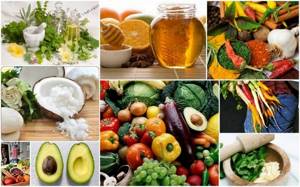
Curd jelly recipe, ingredients:
- Low-fat cottage cheese, 300 grams;
- Gelatin, 1 sachet;
- Low-fat milk;
- Green apples, 2 pcs;
- Pear, 1 pc.
Wash, peel and bake the fruits in the oven, mix the cottage cheese and milk in a blender. Finely chop the apples and pears, dilute the gelatin in warm water, and after dissolving it, mix all the ingredients. Place the container with the mixture in the refrigerator for several hours until it sets; do not eat the cold jelly.
THESE ARTICLES WILL HELP YOU LOSE WEIGHT
Your feedback on the article:
( 1,066 ratings, average: 4.52 out of 5)
Reduce your carbohydrate intake
The need for carbohydrates for people who do not engage in sports or heavy physical labor is on average 400-500 grams per day. Moreover, the share of high-molecular carbohydrates (primarily starch) should account for 350-400 grams, easily digestible sugars (glucose, fructose, sucrose) - 50-100 grams.
The foods that are richest in easily digestible sugars, the consumption of which should be limited as much as possible, or better yet excluded from the diet altogether:
- sugar - contains 99.9% sucrose;
- any flour products, especially those made from white (wheat) flour;
- confectionery: sweets, chocolate, cakes;
- preserves, jams, marmalade, honey.
Also, don’t get carried away with potatoes and cereals (porridges), limit their consumption, but don’t exclude them completely from your diet.
Causes
The main reasons are considered to be:
- Foodborne toxic infections caused by microorganisms of a viral and bacterial nature occur when eating poorly processed food.
- Consequences of antibiotic therapy and certain medications. Pharmacological drugs change intestinal motility and dysbiosis, and dysbiosis can form.
- Stressful situations.
- Irritable bowel syndrome.
- Tumor diseases, polyps, diverticulosis.
- Autoimmune pathologies: ulcerative colitis, Crohn's disease.
- Cirrhosis of the liver.
- Diabetes.
- Atherosclerosis of mesenteric vessels.
- Allergic reactions to foods.
- Smoking, drinking alcohol.
Eat more vegetables and fruits, herbs and berries
Vegetables and greens should form the basis of your diet. They are rich in vitamins, microelements, and contain a lot of dietary fiber and fiber necessary for normal digestion. Eat vegetables both raw - whole or in the form of salads, and thermally processed (boiled, stewed). The optimal ratio of raw and cooked vegetables in the diet of a healthy person is considered to be 2:3, and it is better to eat raw vegetables (as well as fruits) at the very beginning of a meal, as a so-called zero dish, and to eat them together with thermally processed food. and especially for dessert, after the main courses, it is better to avoid.
Fruits and berries can also be consumed almost without restrictions, with the exception of the sweetest ones, such as bananas or grapes. But at the same time, it is better to give preference not to overseas wonders, but to fruits grown in the same area where you permanently live.
Diet for stomach ulcers
During an exacerbation of an ulcer, the diet is quite strict. Bread and vegetables are excluded from the patient's menu. They are replaced with boiled lean meat, porridges, slimy soups, soufflés and jelly. This diet is followed for three weeks. Afterwards, the diet is supplemented with baked fruits, dairy products, boiled low-fat fish, vegetable soups and day-old bread.
During remission, the patient is allowed a more varied menu, which will help restore the proper functioning of the digestive system. The menu includes soups, cheeses, boiled tongue and caviar are allowed. The list of prohibited foods includes onions, garlic, fried and fatty foods.
The main thing is calm
The basis of diets for gastrointestinal diseases is regular, calm, relaxed eating. Eating slowly improves the functioning of the digestive system. It is important to chew your food thoroughly. A sufficient amount of saliva protects the gastric mucosa. Preliminary digestion of starch prevents fermentation in the stomach, therefore, irritation of the mucous membrane with acidic substances. Some experts recommend not eating between meals to reduce acid production caused by food in the stomach. It is inappropriate to eat before bed.
It is equally important to quit smoking. It has been proven that smokers cope with gastrointestinal diseases worse than non-smokers. If you can't quit smoking, try to limit the number of cigarettes (eg, smoke only after meals).
Important! Informational article! Before use, you should consult a specialist.
Mineral deficiency
In case of intestinal diseases, the body receives insufficient minerals, but this deficiency can be replenished with the help of dairy products
. Not only do they contain a lot of minerals, but they are also easily absorbed by the body. Dairy products can provide the body with a sufficient amount of phosphorus and calcium, but one must keep in mind that not all dairy products can be well tolerated by the body in case of intestinal diseases. For example, fresh milk may be too “heavy”, and fermented milk products, due to their increased acidity, can irritate the walls of the stomach.
The most neutral and useful product for intestinal diseases is unleavened cottage cheese.
, as well as unsalted and low-fat
cheese
. These products can be an alternative to kefir and yogurt. It is only important that the products are fresh and natural, without additional spices or flavor enhancers.
